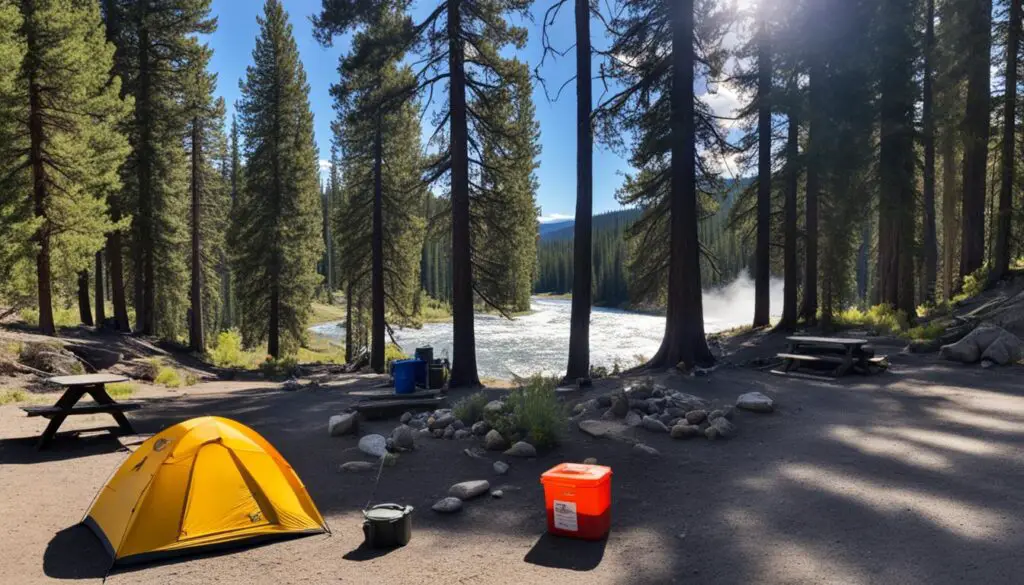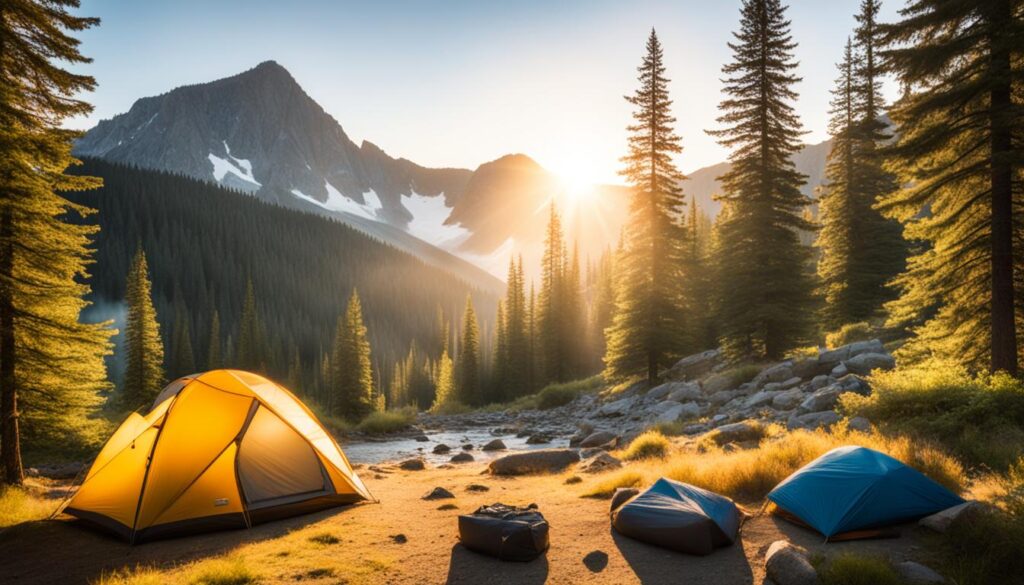Is It Safe to Camp in Yellowstone
Yellowstone National Park is a treasure, dazzling with beautiful nature, wild animals, and loads of things to do outdoors. One of the favorite activities is camping in Yellowstone. It lets you deeply connect with the quiet, untouched parts of the park. But, it’s smart to think about safety. In this story, we will talk about staying safe while Yellowstone camping. We’ll look at the risks, what you should do, and how to have a great camping trip here.
Yellowstone is known for its big outdoor activities and wildlife. But, these also make it important to think about safety when you camp there. You will need to be smart about moving around the park and sharing the space with different animals. I want to make sure you know how to be safe and have fun while camping. This way, you can create lasting memories at Yellowstone.
The Allure of Camping in Yellowstone
Yellowstone National Park stands out as a hidden gem in America’s wilds. It provides unmatched chances for the Yellowstone camping experience. Its open, wild spaces and many animals draw adventurers to experience the true heart of the Yellowstone wilderness. It calls people to start an outdoor adventure in Yellowstone.
Connecting with Nature
Camping in Yellowstone lets you get away from your usual busy life. It helps you feel a strong bond with our natural world. You might fall asleep to a stream’s calming sounds. Or you could wake up to stunning mountain views. The Yellowstone camping experience brings peace and renewal.
Exploring the Wilderness
The vast Yellowstone wilderness hides many special places. This includes clear, high mountain lakes and old volcanic sites.
Camping here lets you step off the regular trails. You get to see the park’s most amazing and less visited spots. This makes for memories you’ll treasure forever.
The geothermal sites and rich wildlife make the Yellowstone camping experience truly unique. It’s perfect for a quiet break or a thrilling outdoor adventure in Yellowstone.
This famous park offers you a special chance to get lost in the beauty of nature.
Potential Dangers in Yellowstone
Yellowstone National Park is an amazing place to camp. But, it has its dangers. Encounters with wildlife and natural hazards like geysers are part of the risk. Visitors need to know how to stay safe.
Yellowstone is known for its dangerous wildlife. Bears, bison, and wolves are not uncommon. To stay safe, campers should be careful with food and trash. This prevents wild animals from coming too close.
There’s also danger from the environment. Environmental risks include sudden storms and volcanic eruptions. These can be a threat to anyone. It’s important to be ready and keep an eye on the park’s alerts.
| Potential Danger | Description | Mitigation Strategies |
|---|---|---|
| Wildlife Encounters | Encounters with grizzly bears, black bears, bison, and wolves can be life-threatening. | Properly store food, avoid approaching animals, and follow park guidelines for wildlife safety. |
| Unpredictable Weather | Sudden thunderstorms, flash floods, and other severe weather can put campers at risk. | Check weather forecasts, be prepared with appropriate gear, and seek shelter when necessary. |
| Geothermal Hazards | Yellowstone is home to numerous hot springs, geysers, and other geothermal features that can be dangerous. | Stay on designated trails, avoid touching or approaching geothermal features, and heed all warning signs. |
To have a great time at Yellowstone, safety comes first. Knowing the dangers and preparing well is key. With good planning and following the park’s rules, the risks from wildlife and the environment can be lower during your trip.
Safety Precautions for Camping in Yellowstone
Camping in Yellowstone National Park is amazing but needs safety top of the list. It’s key to stay safe while enjoying the wild and picking the right spot to stay in.
Preparing for Wildlife Encounters
In Yellowstone, big animals are a main risk. It’s key to know how to keep yourself safe from them. Here’s what you need to do:
- Keep all your food, lotions, and anything that smells in places bears can’t get to or inside your car
- Never cook or eat near your tent and throw away trash the right way
- Learn to spot the signs of animals, like their tracks or droppings
- Stay far from wild animals and never try to get closer to them
Campsite Selection and Setup
Finding and setting up a good spot to camp is big for safety. Think about these when picking where to camp:
- Don’t camp too close to water or trails, as animals might come by
- Look for a place that’s flat and has little plants to avoid falls
- Choose a spot far enough from others to feel you have your own space and to be safe
After picking your camping spot, make sure your tent is set up well and your things are put away safely. Doing this helps make sure your time in Yellowstone is safe and fun.

Is It Safe to Camp in Yellowstone?
Evaluating the Risks
Camping in Yellowstone is a big hit, with millions visiting every year. The place’s beauty and wild side pull in many for adventures. But, it’s smart to check the dangers first. Yellowstone’s wildlife, like bears and bison, can be risky if you’re not careful. Also, its hot springs and geysers are not safe to touch.
Following Park Regulations
Knowing Yellowstone’s camping rules is key to a fun, safe trip. The rules include how to store food safely and how to manage waste. They also talk about where to set up camp and the rules on fires. These tips help keep camping safe in Yellowstone and protect its nature.
To camp safely in Yellowstone, follow the rules closely. Think about the risks and plan carefully to deal with them. This way, your time in the park will be both safe and unforgettable.
| Campground | Number of Sites | Fee (per night) | Open Dates |
|---|---|---|---|
| Norris Campground | 278 | $33 | Early May to mid-October |
| Mammoth Campground | 85 | $25 | Year-round |
| Indian Creek Campground | 70 | $20 | Mid-June to mid-September |
| Pebble Creek Campground | 27 | $20 | Mid-June to late September |
| Slough Creek Campground | 23 | $20 | Mid-June to mid-October |
| Tower Fall Campground | 31 | $20 | Mid-May to late September |
| Bridge Bay Campground | 273 | $39 | Late May to mid-September |
Tips for a Safe and Enjoyable Camping Experience
Going camping in Yellowstone National Park is thrilling. It’s also very important to stay safe. By preparing well, your trip can be fun and memorable. Here’s some top advice for camping in Yellowstone:
- Bring important stuff like a strong tent, sleeping bags, and waterproof clothes. Also, pack a first-aid kit, non-perishable food, water, and a good light source.
- Familiarize Yourself with the Park’s Layout and Resources. It’s wise to know where campgrounds, ranger stations, and help are. This can be a big help in danger.
- Watch out for animals like bears and bison. Learn about Yellowstone safety. Be sure to keep food safe and know what to do if you see an animal.
- Pick a good spot to camp. Choose somewhere that’s flat, near water, and protected from bad weather. Stay away from flood-prone spots and unsafe areas.
- Know the park’s rules. They’re there to keep you and the park’s nature safe. Follow the rules about fires, garbage, and other things to protect the environment.
| Campground | Capacity | Amenities |
|---|---|---|
| Bridge Bay | 432 sites | Flush toilets, showers, laundry |
| Canyon | 273 sites | Flush toilets, showers, laundry |
| Fishing Bridge RV | 310 sites | Flush toilets, showers, laundry |
| Grant Village | 430 sites | Flush toilets, showers, laundry |
| Indian Creek | 70 sites | Vault toilets |
| Lewis Lake | 84 sites | Vault toilets |
| Madison | 278 sites | Flush toilets |
| Mammoth | 85 sites | Flush toilets |
| Norris | 111 sites | Vault toilets |
| Pebble Creek | 27 sites | Vault toilets |
| Slough Creek | 16 sites | Vault toilets |
| Tower Fall | 31 sites | Vault toilets |
By following these helpful Yellowstone camping tips, you’ll have a great, safe time. Always remember, your safety and keeping Yellowstone beautiful are the most important things.
Conclusion
Camping in Yellowstone National Park is amazing but needs good planning. You must understand dangers, obey the rules, and take precautions for safety. This way, your adventure in the park will be safe and rewarding.
Know the wildlife and pick the right spot to camp. Following the advice in this guide will help you feel sure in Yellowstone. Make safety a top priority and show respect for the area. Doing this will help you make great memories and feel close to nature.
If you love camping or it’s your first time in Yellowstone, being careful is crucial. Mixing adventure with responsibility is the key to having a great and safe time. Follow the safety tips and other advice mentioned. This prepares you well for your trip, giving you confidence and peace of mind.
FAQ
What are the potential dangers of camping in Yellowstone National Park?
Yellowstone is full of wildlife like bears, wolves, and bison. These animals can be dangerous. You must also watch out for the hot springs and geysers that may harm you.
How can I safely store food and dispose of waste while camping in Yellowstone?
To keep animals away, store food in bear-proof containers or hang it high. Always properly dispose of trash. This lowers the chance of wildlife coming near your camping spot.
What precautions should I take when selecting and setting up a campsite in Yellowstone?
Pick a spot far from roads, water, and animal paths. Choose a clear area for your tent. Keeping your site clean and secure helps avoid unexpected animal visits.
How can I prepare for and respond to wildlife encounters while camping in Yellowstone?
Know the signs of wildlife. Always have bear spray with you. If you see a bear, slowly walk away without staring or running.
What are the park regulations I need to be aware of when camping in Yellowstone?
Yellowstone has rules about fires, camping permits, and bear containers. Know these rules to camp safely and legally.
What additional tips can you provide for a safe and enjoyable camping trip in Yellowstone?
Bring essentials like a first-aid kit and warm clothes. Get to know the park and its dangers. Being ready and following the rules makes for a great camping trip.
